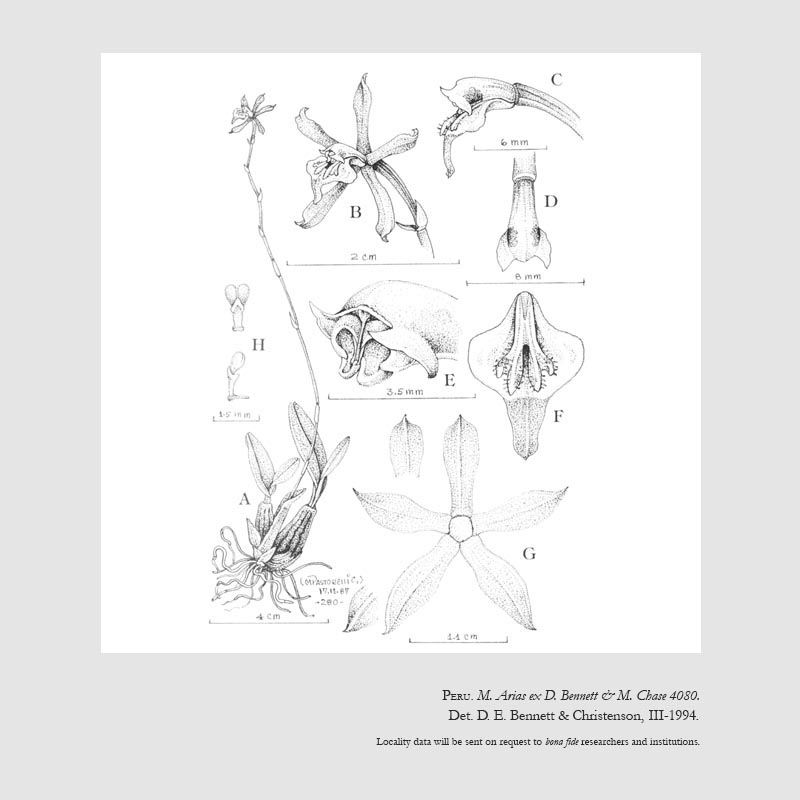
Cochlioda chasei D.E.Benn. & Christenson 1994 = UNPLACED SPECIES See below Pers comm Stig Dalstrom 2021 Drawing by © Benmnet & Christenson and The Epidendra Website

 LATER
LATER

Common Name Chase's Cochlioda [American Born English Botanist and Orchid Enthusiast Current]
Flower Size .7" [1.8 cm]
Found in Amazonas Peru in wet montane forests at elevations around 1700 meters as a small sized, cool growing epiphtye with egg to pear-shaped, laterally compressed, longitudinally grooved pseudobulbs partially enveloped by several pairs of distichous, overlapping, conduplicate, uppermost leaf bearing sheaths and carrying 2, oval to elliptic-oblong, one larger than the other, dark green, acute to rounded, apically notched, narrowing below into the conduplicate, narrow, petiolate base leaves that blooms in the later spring on an erect, 6 to 10" [15 to 25 cm] long, basally, from along the axil, 1 to few flowered inflorescence with 7 to 10 narrowly triangular bracts.
STIG Dalstrom Pers Comm. 6/2021 "Concerning Cochlioda chasei I worked hard on trying to sort that mess out but could not find any evidence that it really existed. I independently talked with Eric Christenson, David Bennet and Mark Chase about this "species" and I got three very different stories, which were not compatible with each other. There obviously was a plant that Manuel Arias, or one of his collectors had found in northern Peru at a location where both "Cochliodas "and "Solenidiopsis" are found. The drawing that was made of it looks like an Odontoglossum (Solenidiopsis) tigrinum to me and not really like any "Cochlioda". The plant has two leaves and the flowers are certainly more like tigrinum than any "Cochlioda" I have seen. According to David Bennett, he gave the plant to Mark Chase who brought it with him to his university in North Carolina (Duke), where it subsequently grew and flowered well. According to Eric, the plant produced a large and branched spike. But according to Mark, he lost the plant in the customs in Miami and never brought anything back to Duke. Then I went looking for the type that was supposed to be deposited at USM in Lima. Well, according to Ricardo Fernandez, the Christenson-Bennett team never deposited any types there because they had some kind of disagreement. So later I found out that the C-B types were at MOL (also in Lima), so I went there to see. And sure enough there are some types there, but no Cochlioda chasei.
So I asked David about this and he said there never was a type of C. chasei, only a pickled flower (which is not at MOL). But then David said that if there is no type then the drawing becomes the type. Not so! That is only for much older descriptions. Modern descriptions need a type specimen to be valid. Anybody can put together "new" species if you can just draw them from your imagination. But according to Eric there really was a type specimen but he could never tell me where it was.
My conclusion was that the illustration looks more like Odontoglossum tigrinum than anything that should be named "Cochlioda", and it was lost, or it was pressed, or only some flowers were pressed, or pickled, or it was never made in the first place, or it was growing in North Carolina, or somewhere else etc. etc. etc. So I decided to leave it at that." Dalstrom 6/2021
Synonyms Oncidium chasei (D.E.Benn. & Christenson) M.W.Chase & N.H.Williams 2008
References W3 Tropicos, Kew Monocot list , IPNI ;
*Brittonia 46(1): 26, 28–29. Benn. & Christenson 1994 drawing fide; Rudolf Schlechter Die Orchideen Band 1C lieferung 32 1977 - 2056 Brieger 1996; AOS Bulletin Vol 71 No 2 2002 drawing fide; Orchid Species Culture: Oncidium, Bakers 2006; AOS Bulletin Vol 77 # 12 2008 as Oncidium chasei
--------------------------------------------------------------------------------------------------------------------------



 LATER
LATER
